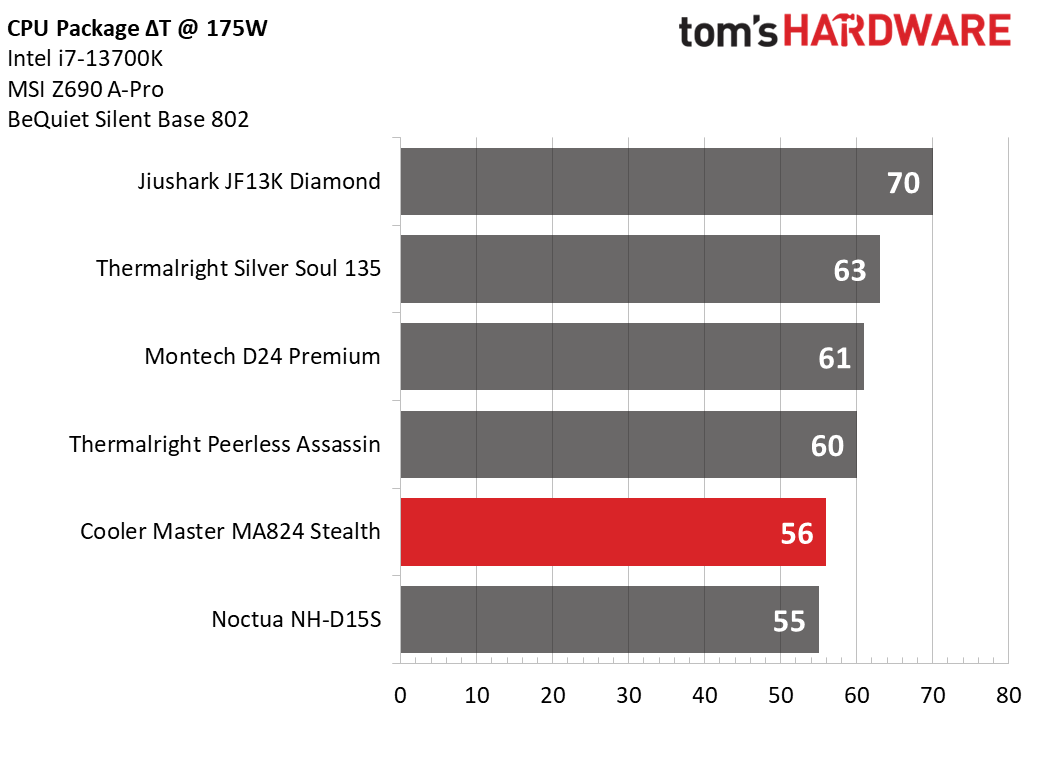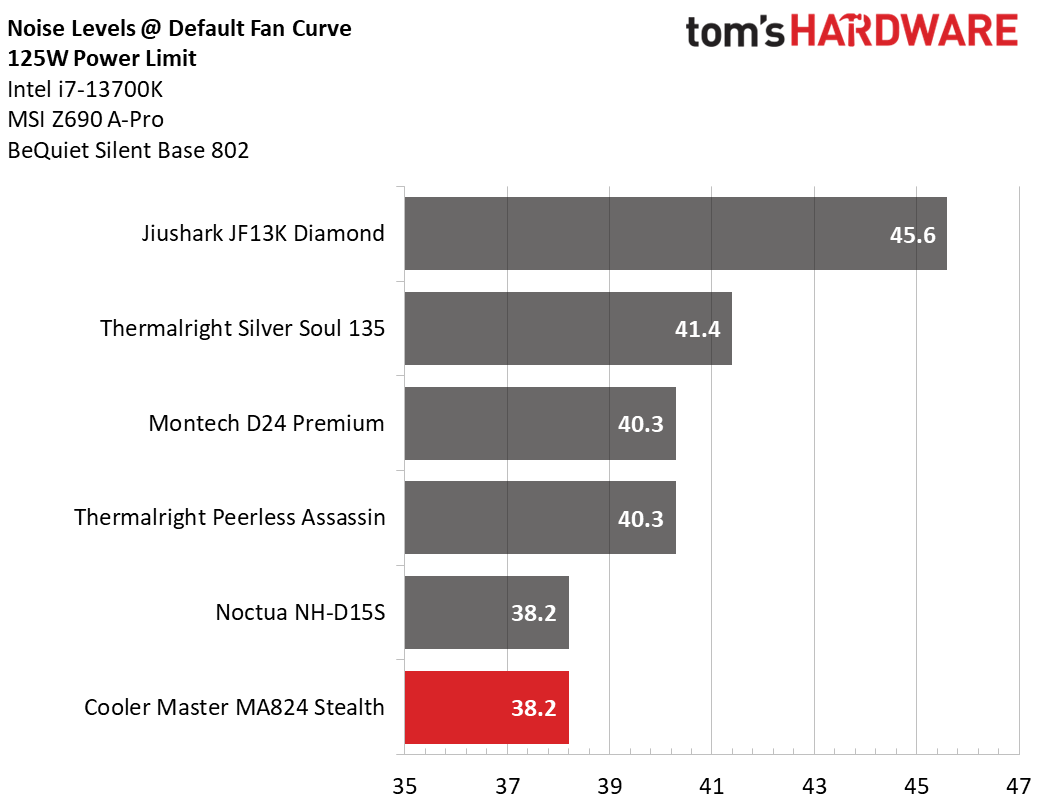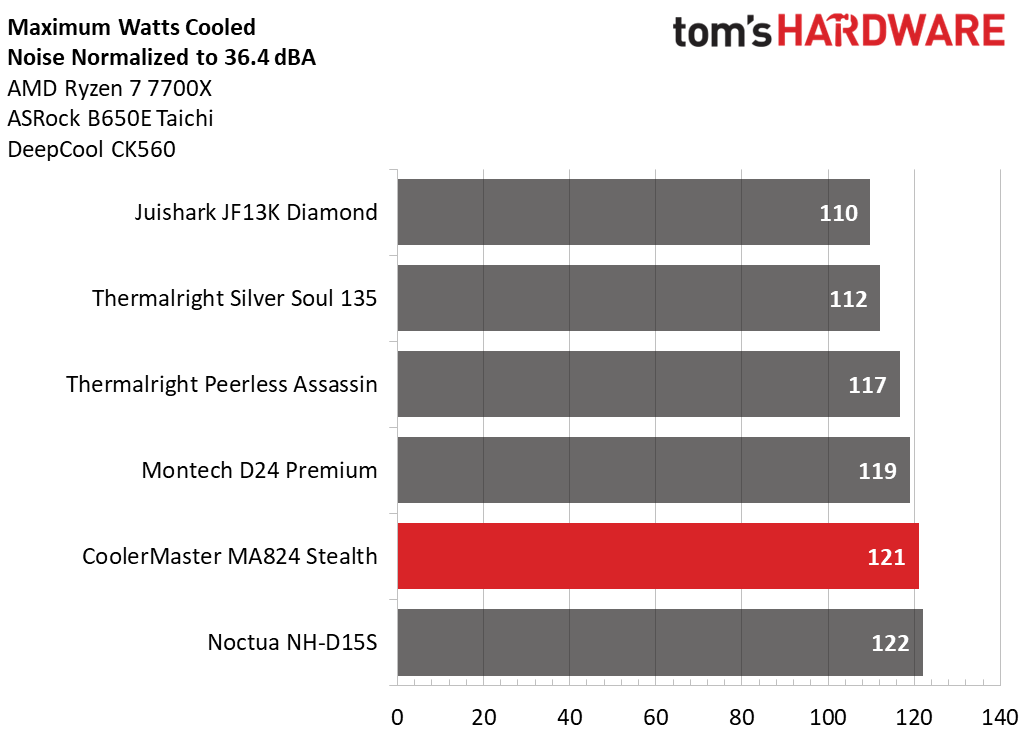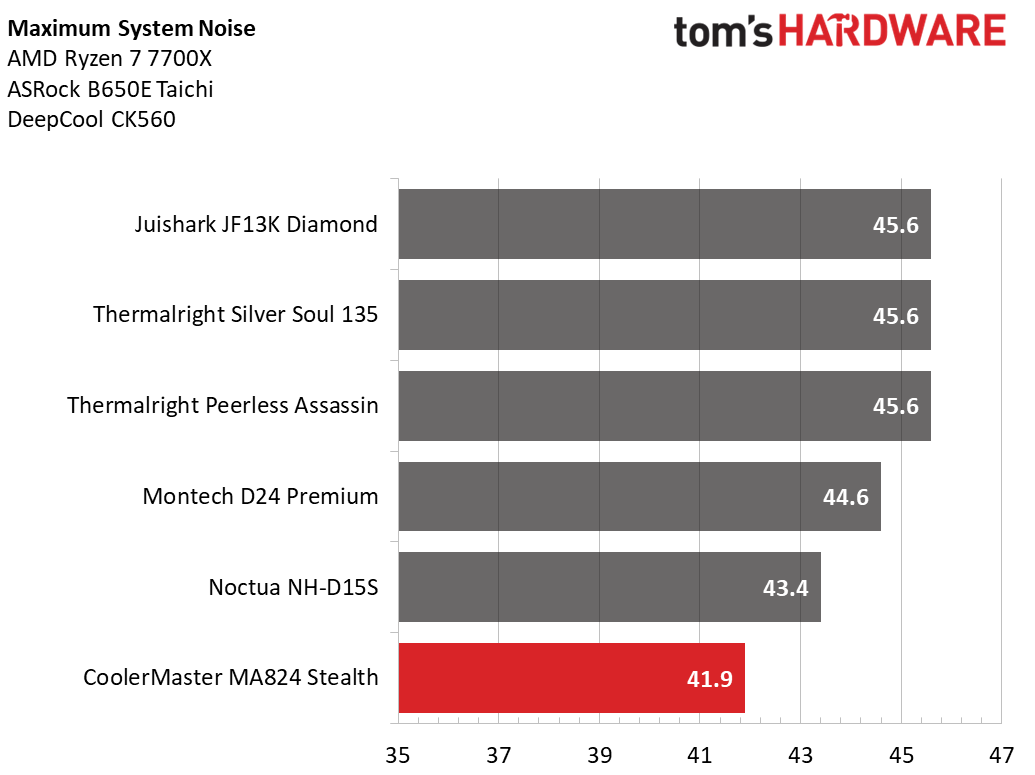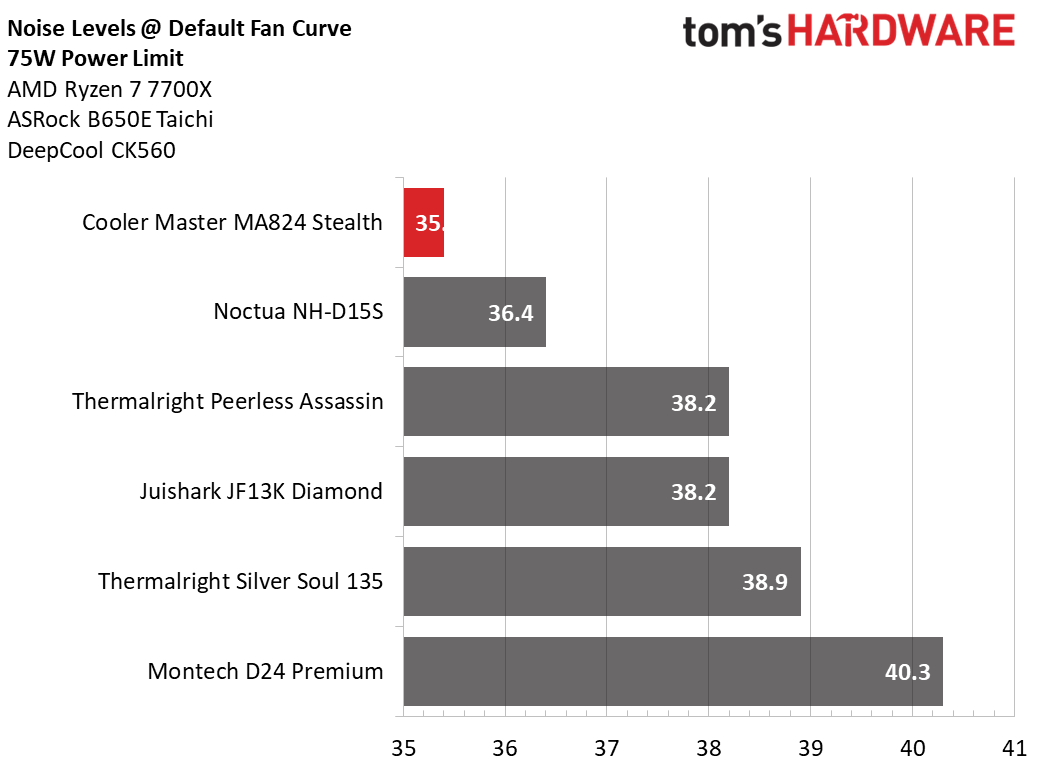Why you can trust Tom's Hardware
Thermal results with noise normalized to 38.2 dBA
Finding the right balance between fan noise levels and cooling performance is important. While running fans at full speed can improve cooling capacity to some extent, the benefits are limited and many users prefer a quiet system.
In this test where the fans are normalized for quiet operation, Cooler Master’s MA824 exhibited the best performance we’ve seen yet, surpassing the competing Noctua NH-D15S by four watts. This isn’t a massive victory, but it is a victory nonetheless and very impressive for an air cooler.
No Power Limits Thermal Results
If you don’t have power limits enforced on Intel’s i7-13700K, it will hit TJMax (peak CPU temperature) and thermally throttle with even the strongest of air coolers. In this test, we measure the total amount of watts the cooler is able to dissipate from the CPU.
Cooler Master’s MA824 Stealth matched the cooling performance of Noctua’s NH-D15S precisely, with an average of 233W cooled during testing. What’s especially impressive is that it maintains this level of cooling performance while running quieter than Noctua’s NH-D15S, at only 41.9 dBA.
175W Cinebench Results
Most coolers on the market are able to keep Intel’s i7-13700K under its peak temperature if the power consumption is limited, so for this test we’ll be looking at the CPU’s actual temperature.
With this slightly restricted workload, CoolerMaster’s MA824 Stealth technically falls behind the Noctua NH-D15S – running a single degree hotter. This performance is achieved with a slightly lower noise level though – 40.9 vs 41.4 dBA – so I’d consider this to be a draw between the NH-D15S and the MA824.
125W Cinebench Results
The lowest power limit I test with Raptor Lake CPUs is 125W. This is a high enough limit to allow the CPU to maintain its base clock speeds even in the most intensive tests, and most coolers should be able of keeping the CPU below Tjmax here – even low-end coolers.
Get Tom's Hardware's best news and in-depth reviews, straight to your inbox.
It’s no surprise that the MA824 delivers chart-topping results in this TDP-restricted scenario. In this test, it matches the cooling performance and noise levels of Noctua’s NH-D15S precisely, with noise levels of 38.2 dBA and a CPU temperature of 44 degrees over ambient.
AMD Ryzen 7 7700X Thermal Results
It’s great to see how coolers perform with hotter CPUs like Intel’s i7-13700K, but that performance doesn’t always directly translate to how other CPUs will operate with the same coolers. With today’s review, I’ve expanded my testing to include AMD’s Ryzen 7 7700X to show how coolers might respond with CPUs that are less thermally demanding.
Thermal Results with noise normalized to 36.4 dBA
With noise levels set to 36.4 dBA, Cooler Master’s MA824 Stealth does very well when paired with Ryzen 7 7700X – cooling 121W on average during testing. This is technically a single watt behind Noctua’s NH-D15S, but we would consider this with the margin of error.
Maximum Cooling Capacity with maximum fan speeds
Our next test is to test the cooler’s maximum cooling capacity by allowing its fans to run at full speed. The Cooler Master wasn’t able to match the NH-D15S in this test, falling behind by 3W. This is a minor defeat, which won’t make any perceptible impact in actual computing performance, but it is a loss nonetheless.
While it does run a few watts behind the competition in total cooling capacity, the MA824 Stealth also runs quieter at only 41.9 dBA vs the 43.4 dBA of Noctua’s NH-D15S. Overall, I would consider this a small win for Cooler Master’s MA824.
Thermals and Acoustics with a 95W Power Limit
Not every task will force the CPU to use its full potential or maximum power draw, so it’s good to test coolers at a variety of power limits. With an average CPU temperature of 53C over ambient, Cooler Master’s MA824 Stealth does well here.
While technically falling behind the competing Noctua and Montech coolers by a single degree in this scenario, the Stealth runs much quieter than these coolers do, at only 38.2 dBA. That’s a win in my book.
Thermals and Acoustics with a 75W Power Limit
With power draw reduced to 75W on AMD’s Ryzen 7 7700X, this thermal load shouldn’t be difficult for most coolers to handle. This is roughly the amount of power the Ryzen 7 7700X CPU will use during gaming, and it’s also the maximum power consumption of AMD’s non-X Ryzen 7 CPU.

At this lower level of power consumption, cooling difficulty isn’t hard at all and even the most basic coolers should have no problems here. Cooler Master’s excellent performance here is of no surprise, but its supremely quiet noise levels of only 35.4 dBA were unexpected.
Truthfully, the noise levels of the MA824 might be quieter than 35.4 dBA, because my sound meter is incapable of measuring below that level. This is a very good result, the quietest I’ve recorded yet.
Conclusion
Cooler Master aimed to create an air cooling champion with the MasterAir MA824 Stealth, and the company certainly achieved its goals. The MA824 Stealth provides supreme cooling performance while running quieter than its direct competitor, Noctua’s NH-D15S. If you can afford its $99 price, you won’t have any regrets if choosing Cooler Master’s MA824 Stealth. It’s a great pairing for any modern Intel or AMD processor.

Albert Thomas is a contributor for Tom’s Hardware, primarily covering CPU cooling reviews.
-
Phaaze88 So this level of performance was already available 8 years ago - about 2.5 years ago, if you wanted the Chromax version.Reply
Ehh. -
deesider Reply
Would be even better if using the Noctua fans...Phaaze88 said:So this level of performance was already available 8 years ago - about 2.5 years ago, if you wanted the Chromax version.
Ehh. -
Phaaze88 Reply
Have doubts, but definitely more expensive...deesider said:Would be even better if using the Noctua fans... -
10tacle I don't like the permanent mount center fan. I'd like to have more control over the fans I can choose down the road. However, for about $30 USD less than what I paid for my NH-D15 (Chromax.BLACK) it's holding its own against it.Reply
Now the interesting thing will be how Noctua's successor to the NH-D15 which is reportedly coming out this fall improves upon the current design and performance. -
Math Geek for the 7700x it is nice to see that for 60% less you can get almost the same performance and just get the peerless assassin :)Reply
no need to spend any more than the $40 for the AMD chip. you only need to spend $100+ if you are running an intel space heater. -
Brian D Smith "Expensive"??? That's a heck of a lot cheaper than your average 'Water Cooler'....and no maintenance.Reply -
YSCCC now the D15S is a single fan version, with the old D15 with dual fan the noise level likely could be lowered by a lot, and for any cooler at this price range I do exect it could be user replacable fans which, when the unfortunate happens, is simply swarpable, and not stuck in the middle hindering airflowReply -
thestryker I'm curious how this and the D15 perform on the 13900K test bench. I have really liked the uncapped wattage tests as they give a great example of cooling capacity (at least on Intel). I'm not sure if the 13700K just doesn't boost as high (or is just a poor bin in this case), but I'd imagine both coolers could handle over 233W.Reply
This isn't the pricing market I'm usually in for air cooling, but that permanent middle fan would certainly rule this one out if I was. -
Albert.Thomas Reply
Well, expensive for an air coolerBrian D Smith said:"Expensive"??? That's a heck of a lot cheaper than your average 'Water Cooler'....and no maintenance. -
Albert.Thomas Replythestryker said:I'm curious how this and the D15 perform on the 13900K test bench. I have really liked the uncapped wattage tests as they give a great example of cooling capacity (at least on Intel).
Thanks!
thestryker said:I'm not sure if the 13700K just doesn't boost as high (or is just a poor bin in this case), but I'd imagine both coolers could handle over 233W.
They would be able to handle more... if paired with a i9-13900K. The i9 can handle more watts both due to better binning, but also because the heat is spread across a larger area because it has 8 more e-cores.
Top end air coolers can handle ~285W on Intel's i9-13900K.




